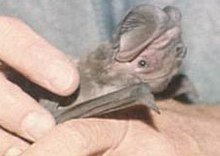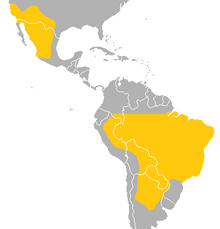Western mastiff bat
| Western mastiff bat | |
|---|---|

| |
| Scientific classification | |
| Domain: | Eukaryota |
| Kingdom: | Animalia |
| Phylum: | Chordata |
| Class: | Mammalia |
| Order: | Chiroptera |
| Family: | Molossidae |
| Genus: | Eumops |
| Species: | E. perotis
|
| Binomial name | |
| Eumops perotis Schinz, 1821
| |

| |
| Geographic Range | |
The western mastiff bat (Eumops perotis), also known as the western bonneted bat, the greater mastiff bat, or the greater bonneted bat, is a member of the free-tailed bat family, Molossidae. It is found in the Western United States, Mexico and South America. This species is the largest bat native to North America, and some of its distinguishing characteristics are its large ears, wings, and forearms.[2][3] The subspecies Eumops perotis californicus is a species of concern as identified by the U.S. Fish and Wildlife Service. The range of this subspecies is principally southwest desert regions of the United States, along the border with Mexico; however, the range extends as far north on the Pacific coast as Alameda County, California.[4]
Range and habitat
[edit]The western mastiff bat is located in both South America and North America. In South America, the species is found in Brazil and its neighboring countries, ranging southward to northern Argentina. It can also be found in Cuba.[5] The subspecies in North America, Eumops perotis californicus, resides in the southwestern United States (California, Arizona, New Mexico, Texas) and ranges southward to parts of central Mexico.[6]
The greater mastiff bat prefers to live in habitats with open space. Some examples include desert scrub, woodlands, and grasslands.[7] Roosts are commonly located in crevices of rocky areas, such as cliffs and canyons,[6] and have also been found within man-made structures such as buildings and tunnels.[7] As the western mastiff bat cannot take off from flat surfaces, these spots are at least 3 meters above ground, providing the bat with sufficient space to drop from and take flight.[6]
Description
[edit]Eumops perotis is most notable for its size, as it is the largest North American bat. It has a body length of 6.2 to 7.2 in (16 to 18 cm)[8] and a wingspan of over 22 in (56 cm).[5] The body mass of this species can range from 60 to 70 g (2.1 to 2.5 oz).[8] The wings are long yet narrow, which limits the species' maneuverability in the air. The body mass of this species can range from 45 to 73 g (1.6 to 2.6 oz).[8] A defining characteristic is its large ears that range between 1.4 to 1.85 in (3.6 to 4.7 cm) and extend over the bat's snout. It also has large forearms with a length of 2.9 to 3.3 in (7.4 to 8.4 cm).[8] Males are larger than females and also have an odoriferous gland on their throat, which is less developed in females.[9] The western mastiff bat is mostly dark in color, as the body is primarily brown or gray, though the underside is a lighter color.[8]
Ecology and behavior
[edit]Western mastiff bats are nocturnal, leaving roosts at night to find food.[6] Unlike most North American bats, they do not undergo either migration or prolonged hibernation, but are periodically active all winter.[2] The size of colonies varies, but they usually consist of less than 100 bats. Males and females live together yearly, even during maternity periods.[2]
The species is very active at night, spending 6–7 hours flying a night for a total distance of about 14.9 miles (24.0 km).[3] Its long, narrow wings allow the bat to maintain flight at high speeds for long periods of time. These bats can reach heights of 196 feet (60 m), though they are also observed flying closer to the ground.[9] One notable characteristic of this species is its high pitched echolocation call, as it can be heard from heights of 990 feet (300 m).[6]
Diet
[edit]The western mastiff bat mainly feeds on small insects. Moths are its biggest food source, but it has been observed to eat beetles, ants, dragonflies, crickets, and grasshoppers.[5][9]
Reproduction
[edit]This species begins mating in early spring and the offspring is born in the summer, usually by July.[9] The gestation period is about 80–90 days, and females give birth to one offspring at a time, though twins are possible.[9] The parturition period varies greatly. The young remain in a nursery after birth, with both the males and females.[9]
Conservation
[edit]Though the western mastiff bat is listed under the Least Concern Category by the IUCN Red List of Threatened Species, Bat Conservation International reports that its numbers are decreasing in certain areas. One reason for its decline is its inability to find suitable water sites for drinking, as its size prevents it from drinking from small bodies of water.[10] Grazing and the use of pesticides have impacted foraging habitats.[2] The loss of cliff sites as a result of urban/suburban development and activities such as water impoundments, highway building, and quarry operations has also contributed to the species' endangered status, making it harder to find adequate roost places.[2]
References
[edit]- ^ Barquez, R. & Diaz, M. (2016) [errata version of 2015 assessment]. "Eumops perotis". IUCN Red List of Threatened Species. 2015: e.T8247A97207171. doi:10.2305/IUCN.UK.2015-4.RLTS.T8247A22026043.en. Retrieved 28 October 2022.
- ^ a b c d e "Western Mastiff Bat (Eumops perotis)". tpwd.texas.gov. Retrieved 2022-10-18.
- ^ a b "Stanislaus River Report". www.dfg.ca.gov. Retrieved 2022-10-20.
- ^ Steven Moore, Endangered Species Survey for Water Treatment Plant Number Two of the Alameda County Water District, Earth Metrics Inc., published by the Alameda County Water District, Report number 10445.003, October, 1990
- ^ a b c Cockrum, E. Lendell (1960). "Distribution, Habitat and Habits of the Mastiff Bat, Eumops perotis, in North America". Journal of the Arizona Academy of Science. 1 (3): 79–84. doi:10.2307/40025030. ISSN 0004-1378.
- ^ a b c d e "Eumops perotis - Vertebrate Collection | UWSP". www3.uwsp.edu. Retrieved 2022-10-19.
- ^ a b "Data Portal". nrm.dfg.ca.gov. Retrieved 2022-10-18.
- ^ a b c d e Best, Troy; Kiser, W.; Freeman, Patricia (1996-12-27). "Eumops perotis". Mammalogy Papers: University of Nebraska State Museum.
- ^ a b c d e f Chebes, Lukasz. "Eumops perotis (western bonneted bat)". Animal Diversity Web. Retrieved 2022-10-19.
- ^ "Eumops perotis". Bat Conservation International. Retrieved 2022-10-21.
External links
[edit]![]() Data related to Eumops perotis at Wikispecies
Data related to Eumops perotis at Wikispecies
- IUCN Red List least concern species
- Eumops
- Bats of North America
- Bats of Central America
- Bats of South America
- Bats of Brazil
- Bats of Mexico
- Bats of the United States
- Mammals of Argentina
- Mammals of Bolivia
- Mammals of Colombia
- Mammals of Ecuador
- Mammals of Paraguay
- Mammals of Peru
- Fauna of the Southwestern United States
- Fauna of the Western United States
- Mammals described in 1821

